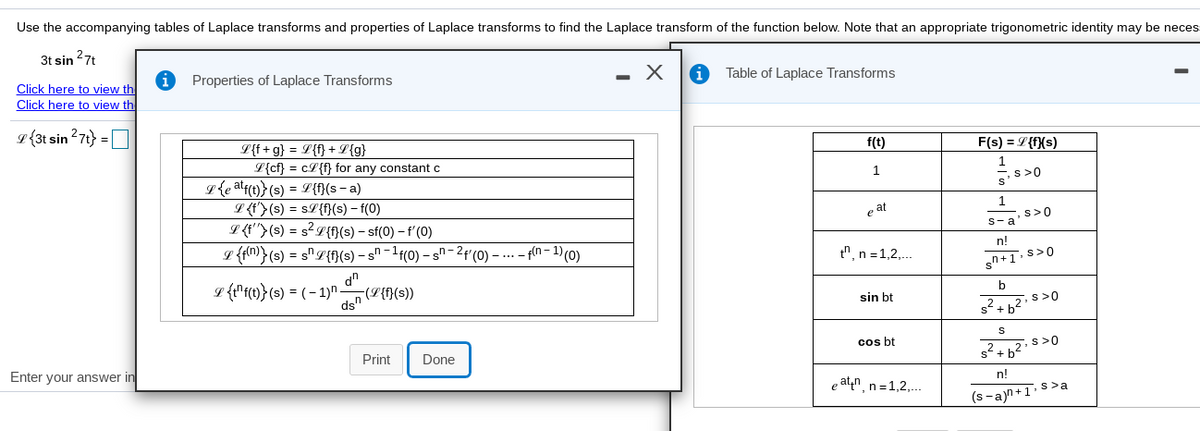Use the accompanying tables of Laplace transforms and properties of Laplace transforms to find the Laplace transform of the function below. Note that an appropriate trigonometric identity may be nece 3t sin 27t Properties of Laplace Transforms Click here to view th Click here to view th i Table of Laplace Transforms L{3t sin 27t} =O L{f+g} = L{f} + L{g} f(t) F(s) = L{f}{s) L{cf} = cf{f} for any constant c 1 s>0 L{e atr1)}(s) = L{}(s - a) L {t'>(s) = sL{f}(s) – f(0) L{t">(s) = s² L{f}{s) – sf(0) – f'(0) L{m}(s) = s^ L{{s) – s^ - 1f(0) – s^- 2f(0) – ..- - fn – 1)(0) 1 e at 1 S-a s>0 n! n,n =1,2,.. sn+1 s>0 L {t^{()}(s) = ( – 1)n(L{0(s)) dsn sin bt Print Done cos bt s>0 Enter your answer in n! e atn̟ n =1,2,.. (s-an+1s>a
Use the accompanying tables of Laplace transforms and properties of Laplace transforms to find the Laplace transform of the function below. Note that an appropriate trigonometric identity may be nece 3t sin 27t Properties of Laplace Transforms Click here to view th Click here to view th i Table of Laplace Transforms L{3t sin 27t} =O L{f+g} = L{f} + L{g} f(t) F(s) = L{f}{s) L{cf} = cf{f} for any constant c 1 s>0 L{e atr1)}(s) = L{}(s - a) L {t'>(s) = sL{f}(s) – f(0) L{t">(s) = s² L{f}{s) – sf(0) – f'(0) L{m}(s) = s^ L{{s) – s^ - 1f(0) – s^- 2f(0) – ..- - fn – 1)(0) 1 e at 1 S-a s>0 n! n,n =1,2,.. sn+1 s>0 L {t^{()}(s) = ( – 1)n(L{0(s)) dsn sin bt Print Done cos bt s>0 Enter your answer in n! e atn̟ n =1,2,.. (s-an+1s>a
Linear Algebra: A Modern Introduction
4th Edition
ISBN:9781285463247
Author:David Poole
Publisher:David Poole
Chapter7: Distance And Approximation
Section7.5: Applications
Problem 28EQ
Related questions
Question

Transcribed Image Text:Use the accompanying tables of Laplace transforms and properties of Laplace transforms to find the Laplace transform of the function below. Note that an appropriate trigonometric identity may be neces
3t sin 27t
Properties of Laplace Transforms
Click here to view th
Click here to view th
Table of Laplace Transforms
L{3t sin 27t} =|
L{f+g} = L{f} + L{g}
f(t)
F(s) = L{f{s)
L{cf} = cI{f} for any constant c
1
L{e atr)} (s) = L{f}{s- a)
L {t'>(s) = sI{f}(s) – f(0)
L {t'">(s) = s?L{f(s) – sf(0) – f'(0)
L {fn)}(s) = s"L{f}{s) – s" -1f(0) - sn-2t'(0) – ... -
1
e at
s>0
s-a
f(n - 1) (0)
tn, n =1,2,...
n!
L {t"f(1)}(s) = (– 1)"
dn
-(L{f}{(s))
ds"
b
sin bt
s+ h2. s>0
cos bt
Print
Done
s2+ b2"
s>0
Enter your answer in
n!
e atn, n=1,2,.-.
(s-a)n+1.s>a
Expert Solution
This question has been solved!
Explore an expertly crafted, step-by-step solution for a thorough understanding of key concepts.
This is a popular solution!
Trending now
This is a popular solution!
Step by step
Solved in 3 steps with 3 images

Knowledge Booster
Learn more about
Need a deep-dive on the concept behind this application? Look no further. Learn more about this topic, calculus and related others by exploring similar questions and additional content below.Recommended textbooks for you

Linear Algebra: A Modern Introduction
Algebra
ISBN:
9781285463247
Author:
David Poole
Publisher:
Cengage Learning

Algebra & Trigonometry with Analytic Geometry
Algebra
ISBN:
9781133382119
Author:
Swokowski
Publisher:
Cengage

Linear Algebra: A Modern Introduction
Algebra
ISBN:
9781285463247
Author:
David Poole
Publisher:
Cengage Learning

Algebra & Trigonometry with Analytic Geometry
Algebra
ISBN:
9781133382119
Author:
Swokowski
Publisher:
Cengage